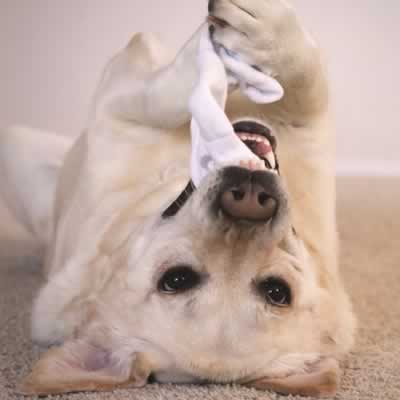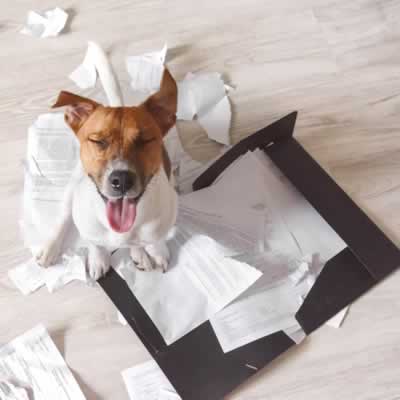Home » Blog » 12 Ways To Puppy Proof Your House – Puppy Proofing Checklist
12 Ways to Puppy Proof Your House

You’re about to welcome home a new puppy! Are the junior-sized food and water bowls ready? Check. A giant case of puppy training pads? Check. Puppy food, chew toys, and a comfy bed? Check, check, check. Now it’s time to puppy proof your house so the newest addition to your family can explore it safely.
Puppy Proofing Checklist
This checklist will help you protect your puppy from hazards while making your life a little easier:
- Stow Trash.
Slide trash cans behind cabinet doors to block access and tempting smells. According to Preventative Vet, a puppy can suffocate while rooting though a potato chip bag in as little as three minutes. In addition to food wrappers, cans with sharp edges, bones, plastic bags, and other waste can be a threat. And don’t forget about the bathroom waste baskets. -
Hang Purses.
Remember the time Fritzie ate your cherry lip balm? Puppies are drawn to scents and love to ransack purses for “yummy” treats such as your toddler’s string cheese wrapper, a well-used tissue, lotions, and makeup.
Sugar-free gum, mints, and even toothpaste made with Xylitol are poisonous to dogs so don’t risk it. Hang purses on hooks or put them away in a secure place. Puppy proofing should address diaper bags, gym bags, backpacks, and briefcases the same way. - Move House Plants.
You probably know that many common house plants are toxic to dogs when ingested, including Aloe, Jade, Ivy, Peace Lily, Dieffenbachia, Philodendron, and Sago Palm to name a few. You may not know that plant material can cause vomiting and other digestive harm to puppies. Play it safe and move plants to high shelves or out of the puppy proof zone. - Watch Electronics.
Puppies. Chew. Everything. To safeguard against choking and internal injuries from small parts, keep TV remotes, cell phones, tablets, video games and controllers, and other small electronics out of reach. Be sure to puppy proof cords by tying them up, taping them down, or running them under rugs and behind furniture. - Relocate Fragile Items.
This may seem a no-brainer, but grandma’s antique tchotchkes aren’t all you need to think about. Water and wine glasses, ceramic vases and bowls, votive candles, and table lamps have a magnetic attraction to wild puppy play. Put your mind at ease and ban them from puppy proofed areas of your house. - Hide Chemicals.
Puppy proof the inside of your house by storing pesticides, antifreeze, weed killer, paint, and other toxic substances outside in the garage or a shed. Place laundry soap and cleaning supplies on high shelves or behind closed doors. And clean spills immediately so your puppy won’t be tempted to lick them up. - Pick Up Your Socks.
And shoes, and belts, and eyeglasses, and stuffed animals, and clarinets. Anything smallish is a potential hazard. Remember: Puppies. Chew. Everything. - Close the Lid.
The lady of the house isn’t the only one who needs this. Puppies drink from open toilet bowls, which harbor bacteria and chemicals, such as bleach. A curious puppy can also fall into a toilet bowl, get injured when slipping, or even drown. - File Your Papers.
Tuck away magazines, books, newspapers, mail, checkbooks, and notepads. While “the dog ate my homework” sounds funny, paper fibers wad up in a puppy’s mouth and cause choking. - Track Office Supplies.
A random paper clip, binder clip, push pin, rubber band, or staple can cause serious injury, even death, if swallowed. Don’t leave any laying around. -
Partition Rooms.
Baby gates are a must when you have a puppy. If your house has narrow doorways and hallways, puppy proofing with pressure-mounted gates will do if they’re tall and sturdy enough for your puppy’s breed and behaviors, including jumping and (you guessed it) chewing.
Consider hardware-mounted or expandable versions with multiple panels to corral large breed puppies and metal gates for those that treat furniture like rawhide. Whatever type you choose, be sure to check the operation. Some gates can be tricky for kids or require two hands, which may keep you from using them. -
Create a Crate Zone.
This may be the most important safety precaution on the puppy proofing checklist because, well, life doesn’t stop for a puppy. In addition to a safe place to sleep overnight, a puppy crate offers your new puppy a little “me time” after too much excitement.
It’s also a safe zone when you need to step away to care for human children, take a shower, or call Aunt Greta to say the puppy made you drop her jellied lamb salad on the floor, and sadly, you won’t get to eat it.
Bringing home a puppy can be quite overwhelming if you’re not prepared. Use our new puppy guide to help you prepare for your new pup!
Source: preventativevet.com (Accessed July 2018).


